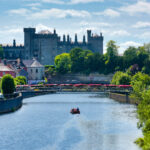Travel blogging has become increasingly popular as more people seek to share their adventures and experiences with the world. A well-managed travel blog can inspire others, provide valuable information, and even generate income. In this comprehensive guide, we’ll cover the essential steps to creating and managing a successful travel blog.
Choose Your Niche
Before you begin writing, it’s essential to decide on a niche for your travel blog. A niche refers to a specific area of focus that sets your blog apart from others and appeals to a particular audience. Popular niches within the travel sphere include solo travel, family vacations, luxury travel, backpacking, and adventure travel. Choosing a niche will help you tailor your content and make it more targeted and appealing to your readers.
Select a Blog Name and Domain
Your blog’s name should be unique, memorable, and relevant to your niche. It should also be easy to pronounce and spell. Once you’ve chosen a blog name, you’ll need to register the corresponding domain name. A domain is the web address (URL) where your blog will be hosted. To register a domain, you’ll need to purchase it through a domain registrar like GoDaddy or Namecheap.
Set Up Hosting and Install WordPress
After securing your domain, you’ll need to find a reliable web hosting provider. Web hosting companies provide server space and resources for your blog to be accessible online. Some popular web hosting providers include Bluehost, SiteGround, and HostGator.
Next, you’ll need to install a content management system (CMS) on your hosting account. WordPress is the most popular CMS for blogs because it’s user-friendly and highly customizable. Many hosting providers offer one-click WordPress installations, making it easy to get your blog up and running.
Choose a WordPress Theme and Customize Your Blog
Once WordPress is installed, you’ll need to select a theme that aligns with your niche and personal aesthetic. A theme is a pre-designed template that dictates your blog’s layout and appearance. There are thousands of free and premium WordPress themes available, so take your time to find the perfect one.
After selecting a theme, you can further customize your blog by adding a logo, modifying colors and fonts, and adjusting the layout. This is where you can inject your personality and brand into your blog.
Create Essential Pages and Navigation
Your travel blog should have several key pages that provide essential information to your readers. These pages may include:
About: Introduce yourself and your travel philosophy.
Contact: Provide a way for readers to get in touch with you.
Destinations: Showcase the countries or regions you’ve visited and link to related blog posts.
Resources: Share your favorite travel gear, apps, and resources.
Disclaimer/Privacy Policy: Include any necessary legal information and disclosures.
Make sure to create a user-friendly navigation menu that includes links to these pages, so readers can easily find what they’re looking for.
Plan and Write Your Content
Now that your blog is set up, it’s time to start writing. Begin by brainstorming blog post ideas related to your niche. Consider including a mix of personal stories, travel guides, and informative articles that provide value to your readers.
When writing your blog posts, keep the following tips in mind:
Write in a conversational tone.
Use attention-grabbing headlines.
Break up your text with subheadings, bullet points, and images.
Include relevant keywords for search engine optimization (SEO).
Edit and proofread your work before publishing.
Incorporate High-Quality Photos and Videos
Visual content is crucial for a travel blog. High-quality photos and videos will not only make
your blog more visually appealing, but they will also help convey the atmosphere and emotions associated with your travel experiences. Here are some tips for incorporating visual content into your blog:
Invest in a good-quality camera or smartphone for capturing high-resolution images and videos.
Learn basic photography and videography techniques to improve your visual storytelling skills.
Edit your photos and videos to enhance their colors, brightness, and overall appearance. Free and paid tools like Adobe Lightroom, VSCO, and Snapseed can help you with this.
Organize your visual content in a way that complements your written content. For example, you could create photo galleries or embed videos within relevant blog posts.
Optimize your images for web use by compressing them to reduce file size and loading times. Tools like TinyPNG or ShortPixel can help with this process.
Promote Your Blog on Social Media
To increase your blog’s visibility and attract more readers, you’ll need to actively promote your content on social media. Popular platforms for travel bloggers include Facebook, Instagram, Pinterest, and Twitter. Use these platforms to share your blog posts, photos, and videos, and engage with your audience by responding to comments and messages.
Create a consistent posting schedule and stick to it.
Use relevant hashtags to increase your content’s visibility.
Share your blog posts on Facebook travel groups and other online communities to reach a wider audience.
Network with other travel bloggers and influencers to build relationships and collaborate on content.
Implement SEO Best Practices
Search engine optimization (SEO) is essential for driving organic traffic to your blog. By optimizing your content for search engines like Google, you increase the likelihood of your blog appearing in search results when users search for relevant keywords. Some SEO best practices for travel bloggers include:
Conduct keyword research using tools like Google Keyword Planner, SEMrush, or Ahrefs to find relevant keywords to include in your content.
Use your target keywords naturally within your blog post titles, headings, and body text.
Write high-quality, in-depth content that provides value to readers.
Optimize your images with descriptive file names and alt text.
Build internal and external links to increase your blog’s authority and credibility.
Monetize Your Travel Blog
Once you’ve established a consistent flow of traffic and built an engaged audience, you can begin monetizing your travel blog. Some popular monetization methods for travel bloggers include:
Affiliate marketing: Promote products and services relevant to your niche and earn a commission for each sale made through your referral links.
Sponsored posts: Partner with brands or tourism boards to create sponsored content in exchange for payment.
Display advertising: Use platforms like Google AdSense to display ads on your blog and earn revenue based on impressions or clicks.
Sell digital products: Create and sell your own e-books, courses, or printables related to your niche.
Offer freelance services: Use your skills in writing, photography, or social media management to offer freelance services to other businesses or individuals.
Conclusion
Creating and managing a successful travel blog requires dedication, passion, and hard work. By following this step-by-step guide, you’ll be well on your way to building a thriving travel blog that inspires readers, shares valuable insights, and generates income. Stay consistent, keep learning, and enjoy the journey!







